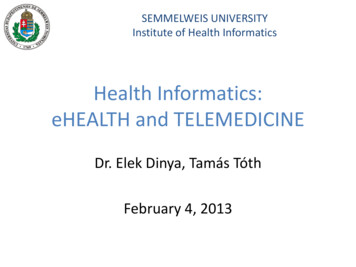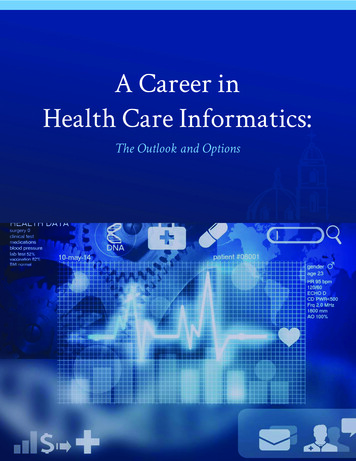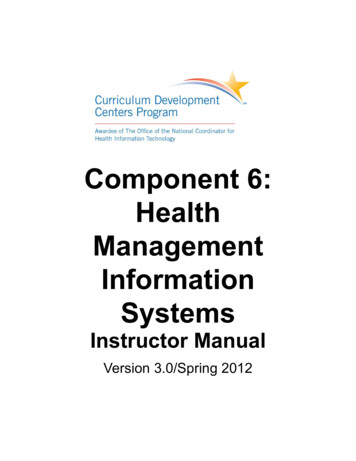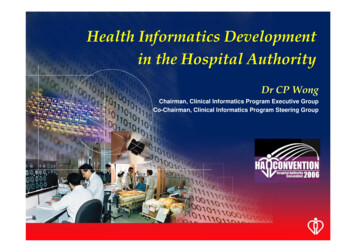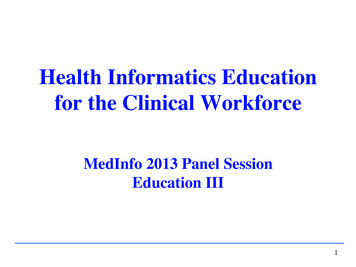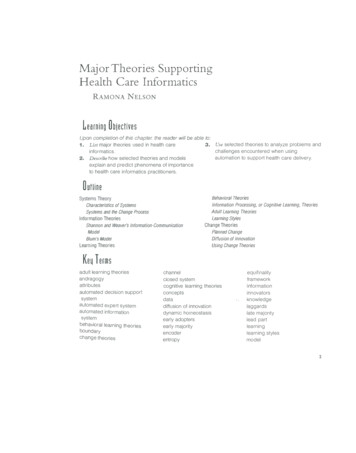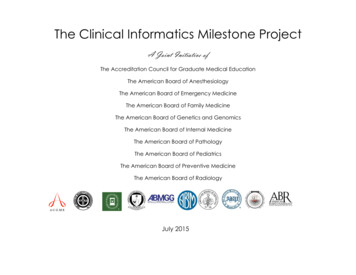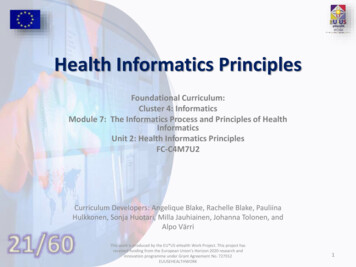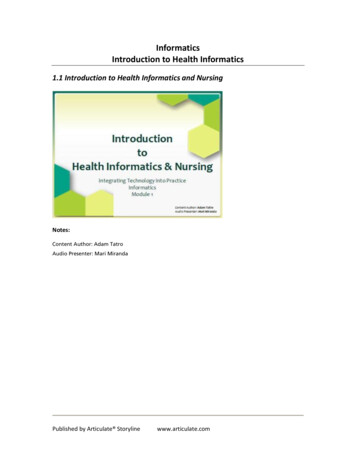
Transcription
InformaticsIntroduction to Health Informatics1.1 Introduction to Health Informatics and NursingNotes:Content Author: Adam TatroAudio Presenter: Mari MirandaPublished by Articulate Storylinewww.articulate.com
1.2 The Future Vision of Healthcare1.3 IntroductionNotes:The video that you just watched is a glimpse into a future where information is readily transmitted inreal time from patient to researcher to provider to patient in a seamless fashion using technology.This flow of information, technology, and its potential use is the basis for the field of Informatics.Published by Articulate Storylinewww.articulate.com
Welcome to the Introduction to Health Informatics and Nursing . This module will answer thefollowing:What are Informatics, Health Informatics, and Nursing Informatics?What are the differences between them and how are they related?Which organizations are active in Informatics and are specific to nursing?What is the nurse’s role within Health Informatics?How do nurses fit into Health Informatics and why should nurses be involved?Towards the end of the module we will briefly explore how this information can be integrated into acurriculum.1.4 Definition of InformaticsNotes:The field of Informatics is relatively young with its first reference not appearing until 1968. As withany young field, it is evolving and changing. As part of that evolution, the scope, definitions, andterminology used is evolving with it. There are many different definitions of Informatics, however themost simplistic definition offered by Hebda & Czar is that Informatics is the science and art of turningPublished by Articulate Storylinewww.articulate.com
data into information. So Informatics is taking data and turning it into information that can be used.1.5 Definition of Health InformaticsNotes:Within Informatics there are several different levels; including Translational Informatics, ResearchInformatics, Legal Informatics, and Health Informatics. It is the latter that we are concerned with.While there are several different definitions of Health Informatics, the National Library of Medicinestates that Health Informatics is "the interdisciplinary study of the design, development, adoption andapplication of IT-based innovations in healthcare services delivery, management and planning."Health Informatics is concerned with taking information generated from data and applying it to allaspects of healthcare.Published by Articulate Storylinewww.articulate.com
1.6 Definition of Nursing InformaticsNotes:To recap, we have Informatics at the highest level with Health Informatics as a subgroup ofInformatics. So where does Nursing Informatics come into play?Within the field of Health Informatics is the sub group of Nursing Informatics. Once again there areseveral different definitions of Nursing Informatics, with two of the most popular coming from theAmerican Nurses Association or the ANA, and the American Medical Informatics Association or theAMIA.The ANA defines Nursing Informatics as “ a specialty that integrates nursing science, computerscience, and information science to manage and communicate data, information, knowledge, andwisdom in nursing practice.” (ANA Practice Scope and standards of Practice for Nursing Informatics2008, P1.)The AMIA states that Nursing Informatics is "the science and practice (that) integrates nursing, itsinformation and knowledge, with management of information and communication technologies topromote the health of people, families, and communities worldwide." (IMIA Special Interest Group onNursing Informatics 2009)You can see that the definitions are worded differently, but the concept is the same. The basic idea isPublished by Articulate Storylinewww.articulate.com
that Nursing Informatics is the infusion of information, knowledge, data, technology, and nursing.Nursing Informatics is the generation of information and knowledge through technology to enrichand enhance all aspects of nursing. So how is this accomplished in nursing? Let us now review hownurses fit into Informatics.1.7 A Nurse's Role in Health InformaticsNotes:Nurses really intersect at both the Health Informatics and Nursing Informatics level. As stated in bothdefinitions from the ANA and the AMIA, Nursing Informatics is concerned with the management andcommunication of information and knowledge. Let’s first take a look at what information andknowledge are.Data is the building block in all of informatics. Without data, information cannot be generated andknowledge cannot be formed. Nurses provide data in many different ways. Nurses collect numericaldata through recording and entering vital signs, ECG analyses, Intake and Output, and other clinicalinformation. Nurses also obtain data from patients, families, and other healthcare team memberswhich is also recorded. Nurses generate data through assessments, notes, and planning.Nurses utilize this data to generate information. Nurses do this by reviewing real time data from aClinical Information system for trends, by integrating data from different information systems, such aslab and radiology systems, to determine patterns, by aggregating data across patients to determineindividual and population trends, or by creating case studies for staff education. These are but a fewexamples of how nurses generate information.Once this information has been generated it is then synthesized into knowledge, which is used toevaluate and initiate intervention. When a nurse evaluates a trend in lab values that then leads to anintervention it is considered knowledge.Published by Articulate Storylinewww.articulate.com
Wisdom is then the culmination of this process, where the knowledge is applied appropriately.1.8 DefinitionsNotes:Published by Articulate Storylinewww.articulate.com
1.9 ExampleNotes:This example will illustrate the four elements. Let us begin with a nurse who enters in vitals for apatient including heart rate, respiration, temperature, and blood pressure; these are all pieces of data.When several sets of these vitals are organized, such as in an Electronic Health Record, and arelongitudinally compared, this is considered information. From this comparison, the nurse mayrecognize that over time the blood pressure has dropped and the respirations have increased; a trendthat is abnormal for the patient. The nurse may then determine that the patient is septic and needsintervention; this is considered knowledge. The nurse then decides on the intervention that is mostappropriate for this patient; this is considered wisdom.Published by Articulate Storylinewww.articulate.com
1.10 Knowledge Check1.11 Knowledge Check(Multiple Choice, 10 points, 1 attempt permitted)Feedback when correct:That's right! You selected the correct response.Feedback when incorrect:Published by Articulate Storylinewww.articulate.com
Part II is the correct response. See below.INFORMATION: The nurse then reviews the urine output over the past 24 hours and notices thatthe patient's urine output has been decreasing over the past 24 hours.Notes:Consider the following scenario and identify which part provides the best example of the elementInformation.A nurse measures the urine output on his patient and enters in the amount into an Electronic HealthRecord.The nurse then reviews the urine output over the past 24 hours and notices that the patient's urineoutput has been decreasing.The patient's record also shows that he has heart failure.The nurse determines that the patient might need some fluid and contacts the provider.The nurse receives an order for fluid and determines that the patient should receive the fluid slowlybecause of the heart failure.The nurse retrieves the fluid and scans the bar code before administering it to the patient.Click on the images below to review parts of the scenario.1.12 Knowledge Check(Multiple Choice, 10 points, 1 attempt permitted)Published by Articulate Storylinewww.articulate.com
Feedback when correct:That's right! You selected the correct response.Feedback when incorrect:Wisdom is the correct response.Notes:Here is an excerpt from the previous scenario. Which element does it best represent?Published by Articulate Storylinewww.articulate.com
1.13 A Part of a TeamNotes:Nurses are but one part of a team that is centered on the patient. In this new age of technology andinformation, with the advent of Personal Health Records and the Internet, a patient has a more activerole in his health care. Along with nurses, other healthcare team members are also interacting withthe four elements to provide care for the patient. Others are entering in data, such as social workersand therapists. Information and knowledge are being generated and formed by providers from theavailable data.The whole team is sharing its wisdom to provide care. In addition, data is being sharedwith patients through their Personal Health Records. Patients are then generating their owninformation and knowledge with the Internet. Nurses, along with other healthcare team members,need to help patients synthesize this information and guide the formation of knowledge and wisdom.Published by Articulate Storylinewww.articulate.com
1.14 Nurses and InformaticsNotes:As we can see, nurses intersect with Health and Nursing Informatics at many levels. As a result of thisinteraction, nurses need to be involved for many reasons. Let us review one example of Nurseinvolvement. . Nurses are being asked more and more to enter data into some kind of electronicsystem, such as an Electronic Health Record. As one of the largest, if not the largest, users of thesesystems, nurses must be involved in the design and implementation of such systems. Systems that aredesigned without nursing input can significantly impact nurse performance and efficiency. There havebeen instances of systems that have increased nursing documentation by 5 times due to poor design.In addition to decreased speed and efficiency, a poorly designed system can lead to an increase inpotential errors. Systems that are too complex can cause incorrect documentation, lack of reviewinginformation due to frustration or inability to find specific information, and aversion to using thesystem. For example, if a system has been designed to display some information in some places andother information in other places, there is an increased chance of important information not beingseen, potentially placing the patient at risk or increasing the chance for error.Published by Articulate Storylinewww.articulate.com
1.15 Nurses and InformaticsNotes:Besides being active in the design of systems, there are other aspects that require nursing involvement.Ethical considerations, policy decisions, patient advocacy, use of such systems and system training allrequire a voice from nursing. As the fields of Health and Nursing informatics increase and grow,nurses will need to play leading roles in the use, design, and implementation of informatics.More information on nursing and informatics is provided in the Resource section of this module.Published by Articulate Storylinewww.articulate.com
1.16 Organizations Relevant to InformaticsNotes:As these fields of Informatics, Health Informatics, and Nursing Informatics evolve, it will be importantto review the most current definitions, competencies, and information for each level. There areseveral different organizations and initiatives that can provide up to date information on what isoccurring in all three levels of Informatics. Some of these organizations include ANA, NLN, HIMSS,AMIA, the T.I.G.E.R and QSEN initiatives. Links for these organizations are listed here and are alsolisted on the Resource page.Published by Articulate Storylinewww.articulate.com
1.17 SummaryNotes:To summarize: Nursing Informatics is a division of Health Informatics, which is a division of Informatics Informatics, Health Informatics, and Nursing Informatics are evolving Nursing intersects with Health and Nursing informatics at three levels: Data, Information, andKnowledge level Nurses should be involved in Health and Nursing Informatics for a variety of reasons including designand workflow considerations There are several organizations and initiatives that are involved with Nursing Informatics There are several theories that support the use of Nursing Informatics, including: Nursing InformaticsTheory, Change Theories, Rogers’ Diffusion of Innovation Theory, Cognitive science and Usability,General Systems Theory, Chaos Theory, and learning theories.Published by Articulate Storylinewww.articulate.com
1.18 Curriculum Integration1.19 Curriculum IntegrationNotes: So how can this information be integrated into your curriculum? Two possible ideas forintegrating are to have student identify different examples of how nurses interact with the threeelements of Nursing Informatics: Data, Information, and Knowledge. In addition, Nurse’sinteraction with these elements can be referenced in other classes, such as data generationduring an assessment course and how that data can be used by other clinicians, or completingflowsheets during a clinical experience.Published by Articulate Storylinewww.articulate.com
1.20 End of PresentationPublished by Articulate Storylinewww.articulate.com
Informatics, Legal Informatics, and Health Informatics. It is the latter that we are concerned with. While there are several different definitions of Health Informatics, the National Library of Medicine states that Health
